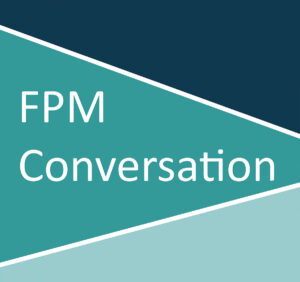FPM Conversation Blog: Pharmaceutical Medicine Liability – “Do I need a get out of jail free card?”
Posted on: Monday 14 December 2020
Author: Written by Craig Hartford & FPM, with content input from all Speaker-Panellists
Summary of Points To Consider arising during the Conversation
prepared by Craig Hartford & FPM, with content input from all Speaker-Panellists
On Thursday 17 September 2020 the Faculty of Pharmaceutical Medicine (FPM) hosted an online event in their series of FPM Conversations, titled Pharmaceutical Medicine Liability – “Do I Need a Get Out of Jail Free Card?”. The session was chaired by Craig Hartforda. Speaker-Panellists included Peter Feldschreiberb, Christopher Batesc, David Morgand and Paul Knightse, and pre-session FPM panellists Susan Bewsf and Penny Wardg participating in the discussion. The topics addressed by the speaker-panellists are outlined in the FPM Conversation meeting’s published agenda.

LEGAL CONCERNS ABOUT MEDICAL PRODUCTS DEVELOPED OR MARKETED TO TREAT SARS-COV-2
- The pandemic has resulted in an enormous effort to produce new medical devices, therapeutics, and pharmaceutics, and to repurpose existing production lines.
- Fraudulent products
Numerous online scams have been removed, which included fake online shops selling fraudulent coronavirus-related products. Many of these products could be classed as defective medicines. - Product volumes
- Efforts to scale up production of existing products can result in manufacturing issues leading to potentially unsafe products, covering a range of PPE and medical devices. In part this may be contributed to by additional fulfillment personnel needed, with minimal to no past experience, requiring rapid training.
- Repurposed production lines
Instances of in-demand products newly being manufactured e.g. Brewdog with hand-gel, or Dyson with ventilators. Some instances of access to small scale novel production facilities (such as 3D printers, or garment manufacturing) to produce and help meet the consumer demand e.g. masks.
- Fraudulent products
- So, what are some of the legal considerations emerging with the ‘new normal’?
Can the determination of liability be affected where the pressure to produce is driven by the pandemic? How should the law balance the need to incentivise entrepreneurs and manufacturers to quickly develop essential medical products without imposing responsibility for adverse effects, to ensure that such innovators are not disproportionately burdened by them?- By law, the producer is liable to compensate for the damage caused by a defective product. There is no specific defense for producing products that are defective.
- In law a defective product is one that failed to “provide the safety which a person is entitled to expect, taking all circumstances into account“. Three statutory factors impact this definition:
- the presentation of the product
- the use to which it could reasonably be expected that the product would be put
- the time when the product was put into circulation
- Production of non-standard products increases risk of a manufacturing defect. The liability for the failures in the manufacturing process doesn’t change the attribution of liability just because the total numbers of the products are increasing. The onus for defending and compensating claims for defective products is typically on the manufacturer precisely because the manufacturer often has an economic position to compensate the consumers.
- Health emergencies aside, one would normally expect the passage of time to increase the level of safety of products that can legitimately be expected. That is why one of the statutory factors that is taken into account by the court is the time at which the product was put into circulation: Article 6(1)(c). Article 6(2) also speaks to that issue by mandating that “[a] product shall not be considered defective for the sole reason that a better product is subsequently put into circulation”.
- A variety of questions arise in relation to products produced rapidly for public health emergency use: What are the benefit-risk evaluations of the product? What is its social utility? What impact do warnings have on legislative safety expectations? What are the issues if e.g. a government bears the cost of damage from products supplied in such an emergency? What kind of contractual indemnities will the government give/be able to give manufacturers and producers of products that may ultimately be proven to be defective?
- The pandemic might be relevant to the assessment of defectiveness concerning whether, and the extent to which, the benefits of a product may be weighed against its risks when considering whether it is effective. This is a particularly pertinent question as regards the development of vaccines. Can a product that will be known to have adverse events be legitimately put into the population at large when the benefit-risk may be equivocal? The benefits of a COVID-19 vaccine treatment or ventilators may be profoundly impacted by the context of the health emergency. If legally relevant, they might weigh so as to lower the entitled level of safety expectation in respect of risk, even including serious side effects. However, this would be a very contentious argument in court.
- Regulatory practices have been amended to assist products entering the market as soon as reasonably possible, but the unknown for any producer is any potential downstream civil liability. Production in an emergency will not per se provide a defense to civil liability, though it might be a factor to be taken into account.
CONSIDERATIONS FOR OPTIMAL COMMUNICATIONS
Communication of Product Information
- You cannot promote a prescription-only-medicine unless it has a marketing authorization, nor promote an indication not yet authorized.
- When dealing with, or advertising to, health care professionals, communications must state facts and avoid making exaggerated claims. The information needs to be balanced, factual, and not misleading. With the repurposing of medicines, regulators don’t like to see claims being made about products with broad indications, for example dexamethasone, unless these specific indications can be backed up with data. Additionally, regulators tend to see any kind of proactive sharing of information as promotional; just the act itself can be promotional. For example, if you were to share your particular data, for example, by email, with a healthcare professional, this would be seen as promotional if it’s not in response to an unsolicited request from them. Even “liking” a press release of a product on LinkedIn could be seen as promotional.
- As it is company’s that are subject to the ABPI Code, breaching the ABPI code is solely a company liability rather than an individual employee’s liability. However, company’s could in principle take disciplinary action against employees responsible for such breaches.
- Some notable cases of risk arising from internal communications can include where companies may not initially be completely forthcoming internally with all information to regulators, such as that which might potentially “paint them in a bad light”. In some instances (legitimately or not) such information has been raised as a potential concern in internal emails by employees. There also instances of whistle-blowers alerting the regulator to potential failure to disclose information. This can trigger an internal investigation, and the company may instruct external lawyers to conduct an investigation and review emails of the personnel who were involved in the matter.
Legal Privilege
- Legal advice privilege can be enforced in order to prevent confidential communications between a client and its lawyer from disclosure in contexts where communications may otherwise need to be disclosed such as product liability litigation or in regulatory investigations. It is based on the idea that individuals and companies should be able to consult their lawyers on their legal rights and obligations with the knowledge that those communications won’t then be subject to scrutiny later.
- When does privilege apply to a particular communication? It has to be confidential, and it has to be created or sent for the dominant purpose of obtaining or giving legal advice. Therefore, it is not the case that all communications with a lawyer will attract privilege. Including the text “legally privileged client-attorney confidential” in the heading of an email/document would not decide whether it is a published confidential communication, however it does help because it indicates what is it intended for. Decisions on privilege ultimately depend on the actual content of the document rather than any heading or description used.
- The privilege belongs to the client (e.g. the company) – there have been instances where an employee could not enforce a privilege over their own emails within the company.
LEGAL RISKS FOR SUPERVISORS/MANAGERS
- Employees have a right to see data about them that is processed by their company. In practical terms, an employee has the right to see every email that you write about them in which they are identifiable. Employment lawyers can therefore readily see if managers have written anything inappropriate regarding their employees.
- You have very limited rights to the privacy of any emails that you write using the company’s systems. A company’s IT policies and privacy notices will expressly allow them to monitor your communication and emails for various purposes.
- Most liability rests on the employer. As such the main claims that an employee might bring, for example unfair dismissal/wrongful dismissal, are going to be between the employee and the employer, rather than the employee and their manager. Even in cases where managers have acted unlawfully, liability can rest on the employer. Areas where individual claims against managers arise include: breach of contract; discrimination; whistleblowing. The manager can be found personally liable for any discrimination or detriment that the employee suffers for having blown a whistle.
- Implied terms of a contract: courts will always find that any employee, thus including those in managerial roles, must perform their duties competently and they must use reasonable care and skill in the performance of those duties. Theoretically, at least, the employer could sue a manager employee for any loss that the employer suffered because of a manager’s carelessness or incompetence, because it would be a breach of contract.
- It is not just the employer who is liable to the employee for the acts of discrimination, it is also the person who carries out that act of discrimination. This is specifically enshrined in the equality act. A manager or supervisor can be personally liable to the claimant for any act of discrimination, whether that be e.g. gender/race/age discrimination or discrimination on the basis of any other protected characteristics. You can also be liable if you mislead your junior manager to commit an act of discrimination. This is why many supervisors and managers may get listed as co-defendants if they have committed an act of discrimination.
- In English law, the employee is legally protected from suffering any detriment from suffering dismissal because they have made what is known as a “protected disclosure.” For an employee to have made a protected disclosure, they must have made a qualifying disclosure of information, which means that the disclosure must have contained information that tends to show that:
- criminal offense has been committed; there has been a failure to comply with a legal obligation; a miscarriage of justice has or may have occurred; the health and safety of an individual is being endangered; the environment is likely to be damaged or has been damaged; or there has been a cover-up of any of those things.
UK QP LIABILITIES POST-BREXIT
Regulations/Guidance
- The UK will require a Qualified Person Responsible For Pharmacovigilance (QPPV) who is notified to the Medicines and Healthcare products Regulatory Agency (MHRA).The UK will require that a Pharmacovigilance System Master File (PSMF) be located in the UK, at a site where the AEs are accessible. Both will be required as of 1 January 2021.
- Detailed guidance was first issued in March 2019 and was subsequently withdrawn in February 2020. Detailed UK PV system guidance (inclusive of UK QPPV) was issued in September 2019.
- Exceptions and modifications to EU guidance on GvP.
- Publication has since been withdrawn (31st January 2020).
- Two new MHRA guidance documents, were then issued (including subsequent updates), to accommodate the Northern Ireland Protocol.
- 1 September 2020: Updated Guidance on Pharmacovigilance Procedures
- 4 September 2020: Guidance on QPPV Including PSMF from 1 January 2021
- Post-meeting update: MHRA has confirmed that the UK QPPV may be located:
-
- In the UK (and act as a QPPV under UK GVP)
Or - In the EU (and act as a QPPV under UK GVP), but is not the same person as the EU QPPV. In addition, a UK Pharmacovigilance Point of Contact must be notified to MHRA (12 month implementation period).
Or - In the EU and is the same person as the EU QPPV. Of note, this person would be required to follow both EU GVP and UK GVP. In addition, a UK Pharmacovigilance Point of Contact must be notified to MHRA (12-month implementation period).
- In the UK (and act as a QPPV under UK GVP)
- Detailed guidance in the form of re-issue of UK exceptions from EU GVP remain pending from MHRA.
QPPVs on a Global Basis
- To manage multiple QPPVs, companies very likely need a global approach:
- Single Global QPPV Office,
- Coordinates and, where possible via formal delegation, perform activities on behalf of local QPPVs,
- Local/Regional QPPVs gain availability to Global QPPV office via routine Council meetings, common internal resources (e.g. Documents repositories, Web Portals, etc.), to ensure sharing of information, benefit/risk communications, outcomes of audits & inspections, etc.
- UK QPPV should fit comfortably into the same model.
Northern Ireland Protocol: Impacts to PV System
- Northern Ireland remains within the United Kingdom with respect to National Laws. Northern Ireland is outside of UK with respect to customs and movements of goods.
- European Commission Notice to Stakeholders (Withdrawal of UK and EU rules for Medicinal Products – 13th March 2020) and MHRA publication of 1 September 2020 stated (post-meeting note: MHRA has provided clarification via webinar meetings since the FPM meeting- accordingly annotations are also included below):
- Centrally Approved licenses (granted by EC) includes Northern Ireland (but not Great Britain) in scope and will follow EU medicinal product law and EU GVP. Responsibility of EU QPPV. (post-meeting note: These products will be listed in both the UK and EU PSMFs.)
- UK National authorisations (granted by UK) which include Northern Ireland in scope will follow UK Human Medicines Regulations and follow UK GVP. Responsibility of the UK QPPV.
- UK National authorisations (granted by UK) for Northern Ireland only – will follow UK Human Medicines Regulations and UK GVP. Responsibility of UK QPPV.
- Medicinal products authorised within Great Britain, excluding Northern Ireland, will follow UK Human Medicines Regulations (HMR) and are under the responsibility of the UK QPPV.
- UK QPPV should not be inheriting any new responsibilities over and above those which a UK based EU QPPV historically or currently has.
- There is some initial lack of clarity with the impacts of the Northern Ireland Protocol (post-meeting note: MHRA has provided clarification via webinar meetings since the FPM meeting- accordingly annotations are included below):
- Where does the responsibility of the EU QPPV and UK QPPV start and end? For example:
- Northern Ireland ICSR (serious and non-serious) submissions required to be submitted into EudraVigilance (EU QPPV). (Post-meeting note: The roles and responsibilities of the QPPVs have been clarified as detailed above.)
- Does MHRA require Northern Ireland (non-serious) ICSRs? EU QPPV or UK QPPV responsibility? (Post-meeting note: Now confirmed. MHRA will require all (serious and non serious) ICSRs from Northern Ireland. The UK QPPV is responsible.)
- Can a Great Britain marketing authorisation (Northern Ireland out of scope) actually exist? (Post-meeting note: All Centrally Approved Products grandfathered from EU will be GB licenses.)
- What is the scope of MHRA inspectorate activities? Northern Ireland marketing authorisations (authorised by UK MHRA), but Northern Ireland component under EU medicinal product laws…? (Post-meeting note: MHRA have confirmed they will remain the Competent Authority for Northern Ireland, including in respect of Centrally Authorised licenses present in Northern Ireland.)
- Where does the responsibility of the EU QPPV and UK QPPV start and end? For example:
a Craig Hartford: Pharmaceutical Physician – member of FPM Policy and Communications Group.
b Peter Feldschreiber: Barrister at 4 New Square and Physician. FPM Treasurer.
c Christopher Bates: Solicitor in the Life Sciences Regulatory team at CMS Cameron McKenna Nabarro Olswang LLP.
d David Morgan: Employment law solicitor at Girlings.
e Paul Knights: Head, Pharmacovigilance Strategy, Policy & Standards, Worldwide Safety. Pfizer UK.
f Susan Bews: Responsible Officer, FPM.
g Penny Ward: Independent pharmaceutical physician, Chair of the FPM Education and Standards Committee, Visiting Professor in Pharmaceutical Medicine Kings College London.







